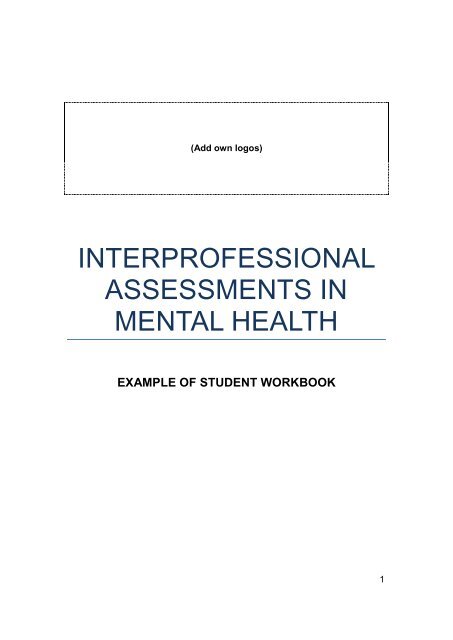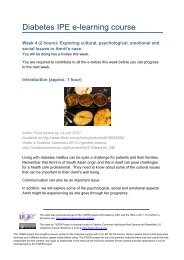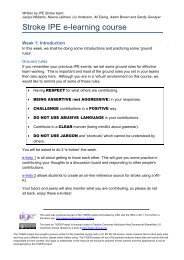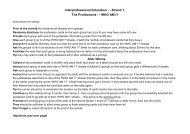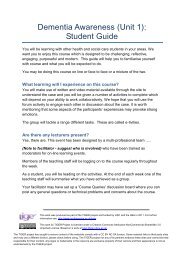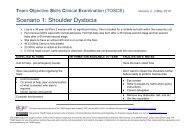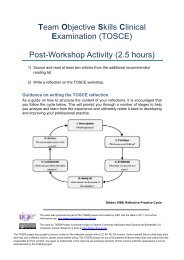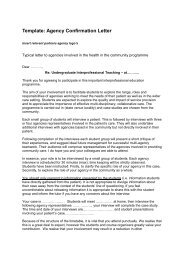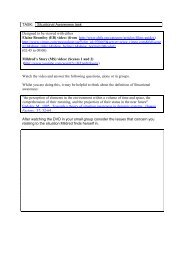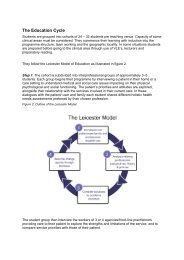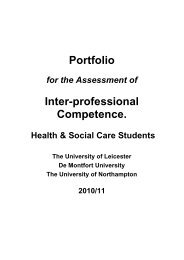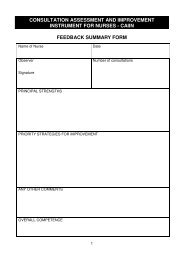Mental Health IPE Event Workbook 2010-2011.pdf - TIGER Home
Mental Health IPE Event Workbook 2010-2011.pdf - TIGER Home
Mental Health IPE Event Workbook 2010-2011.pdf - TIGER Home
You also want an ePaper? Increase the reach of your titles
YUMPU automatically turns print PDFs into web optimized ePapers that Google loves.
ContentsIntroductionCourse Aims & ObjectivesBlock ContactsDates, Venues, Parking, Refreshments and FoodTimetable (sample for two day course)Induction ActivitiesSetting Group Goals<strong>Mental</strong> <strong>Health</strong> Promotion (MHP)What is Stigma?Care PlanningGP Referral LetterConfidentialityPlanning Service User InterviewsMedication ReviewReflection of Service User InterviewPlanning Agency InterviewsReflections of Agency InterviewGuidelines for presentationsQuestions during PresentationsAppendix 1: Exercises on StigmaAppendix 2: Guidelines on Personal Safety2
Appendix 3 Summary of <strong>Mental</strong> <strong>Health</strong> Act 1983/2007Appendix 4: Summary of <strong>Mental</strong> Capacity Act 2005Appendix 5: Who Would be on CPA (Care Planning Approach)?IntroductionOver the next 2 days you will all be immersed in generating a care plan for aservice user with mental health difficulties; most of the patients are based inthe community, but occasionally we use interesting cases who are in-patients.Once placed in your group at the beginning of the first day, you will remainworking with those people for the remainder of the 2 day course. Togetheryou will be interviewing the service user and an agency involved in thatperson‟s care. Many of you will not have met before and you will come fromdiffering professional backgrounds, but there is huge potential to learn a lotfrom each other about how your profession would approach and interact witha mental health service user.Within your group there will be a mixture of students which could includemedics, mental health nursing students, pharmacy students, midwives, or(graduate) social workers. Your group will simulate the experience of workingin a multidisciplinary community mental health team. Together you will write acare plan for the service user you interview and present your findings.This workbook will help to guide you through the process, along with thecourse facilitators. It would be most helpful if you could fill in all of theevaluation forms, so that we can incorporate your comments into thedevelopment of this course. This course has been developed locally to give allof you an experience of working in interprofessional teams and we hope thatyou will both enjoy and benefit from the course.For those of you who have a portfolio, participation in this event will count asevidence. Please ensure you ask one of your tutors to sign this off in yourportfolio.”AimsTo explore the contribution of different disciplines in the mental healthinterdisciplinary working.To apply the social and medical models to holistic interagency careplanning for service users.3
Learning OutcomesKnowledgeAnalyse the importance of the promotion of mental health and theprevention of psychiatric disorders.Appreciate the effects of stigma on service users and their families.SkillsReflect upon your own and society‟s attitudes towards service userswith mental health difficulties.Generate a comprehensive interagency care plan for a service userand evaluate the role of the various statutory and non-statutoryagencies in the delivery of this care plan.Analyse the care given to service users with mental health difficultiesand critically appraise the current working practices.Demonstrate effective communication between agencies andindividuals throughout.Reflect upon how you work in interagency groups.Attitudes or valuesValue the importance of involving service users and their carer‟s in thegeneration of care plans and in identifying unmet physical,psychological and social needs.Be aware of the need to tolerate uncertainty in clinical practice and bemore receptive about the views of others.Develop a positive attitude towards the challenges of working in mentalhealth.Block contactsShould there be any difficulties during the block please do not hesitate tocontact any of the following. On the day of the course please contact thetutors via their phones, as emails may not be answered.For Example:Social Work Students:Medical Students:Nursing Students:Pharmacy Students:(Add own contact)(Add own contact)(Add own contact)(Add own contact)4
Dates and VenuesList dates of two day events plus full address of venue. Several cohorts maybe run throughout an academic yeare.g.Cohort 1Cohort 2…Car Driving, Refreshments and FoodDuring the course you will be going out in your small group to interview aservice user and an agency. This could be some distance from the venue andif you own a car that you usually use to attend your placements, you areasked to bring it with you. If you usually claim for mileage when attending aplacement, or you receive a travel bursary for placements, this course iscounted as part of your practice hours, so the usual arrangements for claimingback your expenses would apply.ParkingAdd own details for each venue as location may be unknown to students.Sample TimetableDay 109:00 Welcome and Introductions - Group working exploring:- Sharing past experience of mental health work- Understanding of professional roles- Medical / Social model- Devising group goals10:00 <strong>Mental</strong> <strong>Health</strong> Promotion:- What influences mental health and well-being- Stigma- Where and how are needs met- Benefits to the person10:45 Coffee5
11:00 Care Planning:- Introduction to interagency care plan template- Discussion of sample care plan- Confidentiality issues12:15 Lunch13:00 Care Planning:- Ongoing sample case- <strong>Mental</strong> Capacity Act / DOLS- <strong>Mental</strong> <strong>Health</strong> Act- Advocacy- Carers Support14:00 Preparing for patient and agency Interviews:- Setting relevant questions- Agreeing who will ask which question etc15:30 Patient Visit16:30 Review of patient interview:- Each student identify 2 questions for Agency Visit16:45 End of day 1Day 209:30 Agency Visit- Must have interview questions ready to ask.- Must have pre-negotiated group roles beforehand.- Be mindful of time – you have one hour.11:00 Return to venue to prepare presentation- A lap top and projector is available if you want to usePowerpoint; also, flipcharts and OHTs.6
- Presentation guidelines are on page 24.- All presentations to last approximately 15 minutes.12:00 Lunch12:45 Complete presentations:- The resource box is available with relevant text books,articles, legislation, BNF etc.1.00 Presentations of interagency care plans to larger group:16:30 Feedback session:17:00 Close- Each presentation should last 15 minutes (max).- Everyone in the group must contribute/attend.- As an audience member you are expected to think ofquestions to ask your peers; see page 25.- Reflection from students- Reflection from the facilitators- Completion of the evaluation formsComment: A range of different lecturers and practitioners with differentexpertise. contribute to the ProgrammeIntroduction ActivitiesWhat experience do I and members of my group have of mental health? Thiscould be formal, or informal.What are the key roles and responsibilities, in mental health for…?Medicine:Social Work:7
Nursing/Midwifery:Pharmacy:Occupational Therapy:How might a mental health service user have experienced stigma? Giveexamples of how, or when, they could be discriminated against:What is the bio psycho-social model? How can it be applied to mental healthby the various professions in your group?8
Setting Group GoalsTo help you to consider some ground rules for your group see the TenEssential Shared Capabilities for the mental health workforce(Hope, R., 2004. The ten essential shared capabilities – a framework for thewhole mental health workforce.URL:http://www.dh.gov.uk/en/Publicationsandstatistics/Publications/PublicationsPolicyAndGuidance/DH_4087169 ).How do these values and examples of good practice influence you?My group discussed and agreed the following rules/goals:Also, as a group discuss whether each of your rules/goals is predominantlyabout a piece of knowledge you hope to learn or understand more fully, askill you want to acquire or develop further, or an attitude/value that youwish to incorporate or be able to demonstrate through working together. Youmust include at least one goal from each of these three categories.9
<strong>Mental</strong> <strong>Health</strong> PromotionWhat is mental health promotion?Wide range of theoretical perspectivesAny action to enhance the mental well-being of individuals, families,organisations or communitiesNational Service Framework – Standard 1 – <strong>Mental</strong> <strong>Health</strong> Promotion :A Quality Framework (HEA 1997)What does it focus on?How individuals, families, organisations and communities think and feelThe factors which influence how we think and feel, individually andcollectivelyThe impact this has on overall health and well-being<strong>Mental</strong> healthWe all have mental health needsIt is more than an absence of mental illnessIt influences: how we think about ourselves and others, our ability tolearn and communicate; to form and sustain relationships; to interpretand cope with change and life eventsHow we think and feel impacts on our physical healthWhere are our mental health needs met?School<strong>Home</strong> and RelationshipsWorkCommunityNeighbourhood and EnvironmentWhere we feel safe; included; valued; respectedBenefits of mental health promotion?Preventing mental ill health particularly depression, anxiety; self harmincluding drug and alcohol dependence and suicideImproving the health and well-being of individuals with mental healthproblems10
Wider universal benefits – improved physical health; increasedemotional resilience; increased social inclusion and participation andimproved productivityChallenging the stigma of mental illnessFor further information please view: <strong>Mental</strong> capital through life: conceptualoverview In: Foresight <strong>Mental</strong> Capital and Wellbeing Project., 2008. Systemsmaps. The Government Office for Science, London. Found at:http://www.bis.gov.uk/foresight/our-work/projects/published-projects/mentalcapital-and-wellbeing/reports-and-publicationsSTIGMA: What is STIGMA ??Secrecy/SilenceTabooIgnoranceGulfMythsAvoidanceMythsPeople with mental health problems are in a minorityPeople with schizophrenia, alcoholism, drug addictions are dangerousto othersIndividuals with any mental illness are unpredictable, hard tocommunicate withPeople with depression, eating disorders, alcoholism and drugaddiction need to pull themselves togetherPeople who commit suicide are selfish11
Results of Stigma• Less than 4 in 10 employers would consider employing someone with amental health problem• 1 in 3 people with mental health problems report beingdismissed/forced to resign• 44% of people with mental health problems thought they hadexperienced discrimination from GPs• 18% would not disclose their condition to a GP• 24% thought individuals with a history of mental health problemsshould be excluded from public officeThe above points are taken from Department of <strong>Health</strong> Research Reporton Attitudes to <strong>Mental</strong> Illness, (2000) 30 March www.dh.org.uk and <strong>Mental</strong><strong>Health</strong> Foundation Survey (2000) “Pull Yourself Together” Aprilwww.mentalhealth.org.uk• 49% had stopped working because of actual stigma and discrimination• Over 30% had experienced actual stigma and discrimination fromfriends• Over 50% fear they would experience stigma and discrimination if theydisclosed their mental health problem• 4% reduction in reported discrimination• 9% drop in discrimination in employers‟ attitudes to individuals seekingjobs• 6% fewer reporting loosing a job due to mental health problem12
(Time to Change Stigma Shout Survey, 2008, London, MovingPeople.org.uk)Care planningDuring this course your group will interview a mental health service user andan agency involved in that person‟s care. As a team you will discuss andprioritise what would need to go into an interagency care plan for thatindividual. The templates for these care plans will be made available to you.You might want to consider the questions you would need to ask the serviceuser directly and which you might prefer to ask the professional.Most mental health trusts now have a policy of offering service users copies oftheir care plans and all correspondence written by professionals involved intheir care. Therefore, you must be comfortable for the service user to readanything you have documented.At the end of this process, on the afternoon of day 2, you will need to feedback aspects of your care plan in a presentation to the wider group.Simulated ActivityYou are asked to imagine you are part of a mental health inter-professionalteam, representing the professional you are training to be.1. To start the simulated activity off, you will receive a referral letter from aGP, asking you to review one of his elderly patients being cared for inthe community. Discuss the content of the letter.2. You are given an old care plan to look at. Apparently, this patient wasassessed six months ago, but no services were required at that time.Initially, skim read the care plan quickly, what are your group‟simmediate thoughts about it?3. As a team you must now discuss each section of the care plan indetail, to review the information included. Does it seem accurate ? Doyou feel it contains enough detail about the patient‟s situation ? Do youagree this patient has no need of additional support or services ?4. If there is any additional information you would like to have, you canask the facilitator. The facilitator will not volunteer any details – youmust ask the relevant and poignant questions.5. As you gather more information, you will start to generate an improvedand up-dated care plan, which reflects the detail and depth required toproperly document a person‟s circumstances.6. Be prepared to share some of your ideas with the larger group.13
Sample GP REFERRAL LETTER of a fictitious patient :Add fictitious address of GPNon Urgent ReferralDear Community <strong>Mental</strong> <strong>Health</strong> TeamRe: Mr Anil Maisuria Dob 26/10/1931(Add fictitious address)I wonder if you would agree to see this pleasant 78 year old gentleman. Youpreviously saw him at home 6 months ago for an assessment. He seems tobe getting more confused and the family are struggling to cope with him. Ihave prescribed some diazepam which the family give him when he getsagitated. The wife has a very supportive son and daughter in law, but came tosee me to ask if there was other medication that could help. I have not beenable to see Mr Maisuria as he did not want to talk to me.Many thanksDr JonesCurrent PrescriptionBendroflumethiazide 2.5mg odSimvastatinAspirin20mg od75mg odDiazepam5mg as required tds14
Past HistoryHypertension 1985Hypercholesterolaemia 1993Atrial Fibrillation 1993CVA 2004Confidentiality StatementOpportunities to have access to members of the public brings with it insightsinto personal lives. At no time can you discuss your encounters in publicplaces. This includes corridors of hospitals, canteens, coffee bars, in a taxi, onpublic transport etc. Your common sense tells you that handling thisinformation in verbal and written form is a privilege of your position and mustbe taken seriously at all times.During this course you will be given a case summary detailing the serviceuser you are to visit. This case summary will include the service users nameand address. It will also include confidential material relating to the serviceuser‟s health and social status. The case summary must not be removedfrom the teaching venue. Your group must record the patients’ addressseparately for the visit. In your notes you must only refer to the patientby use of their initials.You also need to consider what you will do as a group if the patient tells yousome information in confidence.The service user you are visiting tells you that he has stock piled medication,and has planned a suicide attempt. He forbids you to tell anyone about this.What do you do?…………………………………………………………………………………………..…………………………………………………………………………………………..…………………………………………………………………………………………..The service user you are visiting confides in you, in great distress, that she isstruggling with her baby of 8 months. She admits at times to smacking andshaking the baby when he is crying. She does not want you to tell anyone asshe is worried the baby will be taken into care. What do you do?…………………………………………………………………………………………..15
…………………………………………………………………………………………..…………………………………………………………………………………………..Planning Service User InterviewsDuring this session you and your group need to consider how you are going toconduct your interview. You should have copies of the blank interagency careplan which you will need to complete for that service user. You will also havea copy of the service users‟ case summary detailing their diagnosis, andgiving some background information. The service user has seen the casesummary and has agreed the information contained within it. You will have theopportunity to spend up to one hour with the service user. You may also havethe opportunity to question the next of kin/carer. You need to consider howyou as a group will manage this.Here are a set of guidance notes which you might find helpful to readand consider.Plan your questions carefully. You have a copy of the blankinteragency template. Consider what information you need to get fromthe patient, the agency, and if applicable the next of kin, to completethe care plan.You will be given a case summary. This will give the diagnosis and asynopsis of the past psychiatric history and current mental state. Youdo not need to spend much time on the interview reviewing this.You need to concentrate on asking questions designed to elicit theimpact of the mental health problems on the service user‟s, social,occupational, family and wider lifestyle.Consider formulating a set of questions under the individual headingsin the interagency care plan.Example: Under Accommodation and Environment (page 5 of the care plan)- Who do you live with?- What is the relationship between the service user and others in thehouse ? (Links to current support network)- Who owns the house?- Is it privately rented, council, housing association, or is it ownedoutright, mortgage etc?- Who pays the rent, mortgage? (Links to any financial difficulties)16
- Is the house in good order?- Is the house large enough for those living there to have their ownpersonal space?- Is the house appropriate for the service user and their family?- What are the neighbours like?- Are there any difficulties in the local communityYou might find the following themes also useful to consider.Plan your IntroductionGreet service user by name.Introduce the small group.Orientate the service user: mention purpose of the interview, timeavailable, need for note taking and obtain permission to continue.Impact on the service user and their familyEstablish the effect of the condition on job and daily routines of life.The social consequences of the condition.The effects on leisure.Effects on psychological state - self confidence, loss of role in life etc.Effects on the relationships within the family.Effects on relationship with members of the community.Service user’s view of the condition and priorities for the futureElicit their attitude towards the condition and identify their priorities.Establish the extent that they feel involved in decision making.Service user’s experiences of agency involvementDetail all the agencies statutory and voluntary. Clarify the strengths andweaknesses from the service user‟s perspective.Establish the referral pathway and accessibility and waiting list of eachorganisation from the service user‟s point of view.Elicit the outcome of contact with each organisation.17
General Points to consider:Decide which of you is going to ask specific questions. It is importantthat all members of the group take a turn in leading the interview.Decide who will keep notes.You might find it useful for one person at any point in the interview toobserve the service user and interviewers non verbal communication.Decide how you will manage the situation if there are carers/familypresent. Do you interview together or separately? Do you stay togetheras a group of 4, or split into 2 groups of 2.Please be aware of time, one member of the group needs to monitorthis during the interview, and you need to consider what you will do ifyou feel that the service user is talking about an issue at length.Appropriate interruption may be required if the client is unable to focusupon the questions e.g. „that is very interesting, however can I justbring back to the … etc‟.Interview with Service User in the CommunityYou need to ensure that you leave enough time to get to the person‟s home,or other allocated venue. Students are expected to plan and make their ownway to this address. You have one hour to interview the service user and ifapplicable their next of kin and/or main carer. The interview needs to startpromptly at the designated time. If you encounter any difficulties during thevisit please contact one of the tutors immediately. On finishing the interview,thank the service user and leave the property. Once you have left you mustphone the tutors to let them know. If the number is engaged, please phoneagain in 5 minutes, and continue to try, until you have reached one of thetutors. If the tutors have not heard from you they will phone you. If you haveany immediate concerns about anything associated with the visit, theseshould also be communicated to the tutors at this time.Please remember not to write the patients name or address within theworkbook. This should be kept separate and the details destroyedappropriately.………………………………………………………………………………………………………………………………………………………………………………………………………………………………………………………………………………………………………………………………………………………………………………………………………………18
………………………………………………………………………………………………………………………………………………………………………………………………………………………………………………………………………………………………………………………………………………………………………………………………………………………………………………………………………………………………………………………………………………………………………………………………………………………………………………………………………………………………………………………………………………………………………………………………………………………………………………………………………………………………………………………………………………………………………………………………………………………………………………………………………………………………………………………………………………………………………………………………………………………………………………………………………………………………………………………………………………………………………………………………………………………………………………………………………………………………………………………………………………………………………………………………………………………………………………………………………………………………………………………………………………………………………………………………………………………………………………………………………………………………………………………………………………………………………………………………………………………………………………………………………………………………………………………………………………………………………………………………………………………………………………………………………………………19
…………………………………………………………………………………………………………………………………………………………………………………………………………………………………………………………………………………………………………………………………………………………………………………………………………………………………………………………………………………………………………………………………………………………………………………………………………………………………………………………………………………………………………………………………………………………………………………………………………………………………………………………………………………………………………………………………………………………………………………………………………………………………………………………………………………………………………………………………………………………………………………………………………………………………………………………………………………………………………………………………………………………………………………………………………………………………………………………………………………………………………………………20
Medication reviewThis grid is for the use of students not familiar with common psychiatricmedication. Of particular importance, consider whether the side effect of thesedrugs may interfere with the patient‟s quality of life.To the average lay person, could any of the side effects be regarded as „oddbehaviour‟ and mistaken for symptoms of their mental illness?Name ofWhat is itWhat isCommon SideMedicationFor ?the Dose?Effects21
Reflection of Service User InterviewIndividually, and then in your small groups, look back over yesterday‟sinterview with the service user.What 3 things do you feel you did well as an individual?1…………………………………………………………………………………………2…………………………………………………………………………………………3…………………………………………………………………………………………What 3 things did you feel you did well as a group?22
1…………………………………………………………………………………………2………………………………………………………………………………………...3…………………………………………………………………………………………What 3 things would you do differently next time?1…………………………………………………………………………………………2…………………………………………………………………………………………3…………………………………………………………………………………………Any other thoughts or reflections about this experience:……………………………………………………………………………………………………………………………………………………………………………………23
Interview with the AgencyYou need to ensure that you leave enough time to get to the agency workersbase. Students are expected to plan and make their own way to this address.You have one hour to interview the agency worker. The interview needs tostart promptly at the arranged time and finish promptly. The interview may nottake an hour, in which case you are welcome to return to the teaching venue.If you have any difficulties during the visit please contact the tutors. You aredue back to the teaching venue by 11:00am. (or give own time based onprogramme)………………………………………………………………………………………………………………………………………………………………………………………………………………………………………………………………………………………………………………………………………………………………………………………………………………………………………………………………………………………………………………………………………………………………………………………………………………………………………………………………………………………………………………………………………………………………………………………………………………………………………………………………………………………………………………………………………………………………………………………………………………………………………………………………………………………………………………………………………………………………………………………………………………………………………………………………………………………………………………………………………………………………………………………………………………………………………………………25
………………………………………………………………………………………………………………………………………………………………………………………………………………………………………………………………………………………………………………………………………………………………………………………………………………………………………………………………………………………………………………………………………………………………………………………………………………………………………………………………………………………………………………………………………………………………………………………………………………………………………………………………………………………………………………………………………………………………………………………………………………………………………………………………………………………………………………………………………………………………………………………………………………………………………………………………………………………………………………………………………………………………………………………………………………………………………………………………………………………………………………………………………………………………………………………………………………………………………………………………………………………………………………………………………………………………………………………………………………………………………………………………………………………………………………………………………………………………………………………………………………………………………………………………………………………………………………………………………………………………………………………………………………………………………………………………………………………26
…………………………………………………………………………………………………………………………………………………………………………………………………………………………………………………………………………………………………………………………………………………………………………………………………………………………………………………………………………………………………………………………………………………………………………………………………………………………………………………………………………………………27
Reflection of Agency InterviewIndividually, and then in your small groups, look back over the interview withthe agency. Review the good practice guidelines on page 11 – do you feelthat your agency demonstrated all, some or none of these competencies?What 3 things do you feel you did well as an individual?1…………………………………………………………………………………………2…………………………………………………………………………………………3…………………………………………………………………………………………What 3 things do you feel you did well as a group?1…………………………………………………………………………………………2…………………………………………………………………………………………3…………………………………………………………………………………………What 3 things would you do differently next time?1…………………………………………………………………………………………2…………………………………………………………………………………………3…………………………………………………………………………………………Any other thoughts or reflections about this experience:……………………………………………………………………………………………………………………………………………………………………………………28
Guidelines for PresentationsYou will have no more than 10 minutes for your group presentation.There is an expectation that every member of the group will participate in thepresentation.The facilities available to you are:Laptop and Powerpoint (If you have your own laptops please bringthese along for preparing your session)Flipcharts and pensTransparencies, pens and overhead projectorThe presentations need to be focused and clear. We expect you to briefly:Summarise the case briefly.Present the key features of the care plan i.e. the selected 3 or 4sections that were deemed to be of greatest importance, or relevance.Illustrate you have considered the objectives of this course set out onpage 4 of this workbook.Discuss the relevance of broader issues discussed within the coursee.g. health promotion, stigma, carer involvement, advocacy etc.Recognise any other barriers the service user has faced in trying to livea „normal‟ life in the community.Consider how relevant legislation or health/social policy has influencedaspects of how the case is managedCritically appraise the current working practices and communicationbetween agencies and individuals involved with the case.Evaluate how effectively you worked as an interprofessional group.It is also very useful to look at how this course might have changed yourperceptions and beliefs about:- <strong>Mental</strong> health in general- The people who access mental health services- The breadth and scope of professional roles involved29
- What will you each take forward from this course into practice?At the end of the presentation your group will be asked questions from theaudience for 5 minutes. Audience members are expected to activelycontribute to this session. It is recommended that you jot down questions,during the presentations, to be answered by the group.Questions during the PresentationsIt is an important skill to be able to critically appraise another group and to beable to ask poignant questions to clarify your understanding. At the end of thepresentation each group will be asked a series of questions, ideally, theseshould come mainly from their peers in the audience. Below there is space towrite down some thoughts whilst listening to the other presentations and thinkabout a question you want to ask.Questions for Presentation 1………………………………………………………………………………………………………………………………………………………………………………………………………………………………………………………………………………Questions for Presentation 2………………………………………………………………………………………………………………………………………………………………………………………………………………………………………………………………………………Questions for Presentation 3………………………………………………………………………………………………………………………………………………………………………………………………………………………………………………………………………………Questions for Presentation 4………………………………………………………………………………………………………………………………………………………………………………………………………………………………………………………………………………30
Questions for Presentation 5………………………………………………………………………………………………………………………………………………………………………………………………………………………………………………………………………………Questions for Presentation 6………………………………………………………………………………………………………………………………………………………………………………………………………………………………………………………………………………Questions for Presentation 7………………………………………………………………………………………………………………………………………………………………………………………………………………………………………………………………………………31
APPENDICIES32
APPENDIX 1What is Stigma?“the situation of the individual who is disqualified from full social acceptance”(Goffman 1970)In the original meaning from the Greek it refers to the brand with which slavesand criminals were marked. Goffman, (1963) argued that stigma is a mark ofsocial devaluation. It is associated with shame which may be internal orexternal, and when extreme felt as humiliation.Look at the images on the next page. Select one or two of them to focuson. What are your first thoughts about them ?………………………………………………………………………………………………………………………………………………………………………………………………………………………………………………………………………………………………………………………………………………………………………………………………………………………………………………………………………………What role does the media play in contributing to the stigma ofindividuals with mental health difficulties?……………………………………………………………………………………………………………………………………………………………………………………………………………………………………………………………………………………………………………………………………………………………………………………………………………………………………………………………………………………………………………………………………………………………How might we as health and social care professionals in mental healthcontribute to an individual service user’s sense of being stigmatized ordevalued?…………………………………………………………………………………………………………………………………………………………………………………………………………………………………………………………………………………………………………………………………………………………………………………………………33
Image 1:Sorrow SuffocatesI'm having bad mood swings just now. One moment I'm fine, the next &sobbing my heart out, then feeling angry!So much for the "mood stablizers"!!!
Image 2"Cornered," © 2006 Flyzipper, Found at:http://www.flickr.com/photos/flyzipper/198217425/Used under a Creative Commons Attribution-Non-commercial-ShareAlike 2.0 Generic license:http://creativecommons.org/licenses/by-nc-sa/2.0/deed.en_GB35
Image 3:"Hurting," © 2009 Alice Chapman, Found at:http://www.flickr.com/photos/alan_c/3234412417/Used under a Creative Commons Attribution-Non-commercial-ShareAlike 2.0Generic license: http://creativecommons.org/licenses/by-ncsa/2.0/deed.en_GB36
Image 4:"<strong>Home</strong>less people on the move," © 2009 Ed Yourdon, Found at:http://www.flickr.com/photos/yourdon/3892862254/Used under a Creative Commons Attribution-ShareAlike 2.0 Generic license:http://creativecommons.org/licenses/by-sa/2.0/deed.en_GB37
Image 5:Downtown on Dunsmuir. I'm seeing fewer homeless now that winter is nigh,but the ones I'm seeing are obviously unable to cope - either mental illness oraddiction or both..."October 2005," © 2005 Thomas Quine, Found at:http://www.flickr.com/photos/quinet/53931028/Used under a Creative Commons Attribution 2.0 Generic license:http://creativecommons.org/licenses/by/2.0/deed.en_GB38
APPENDIX 2: Guidelines for Personal SafetyImportant things to remember:Travel as a team to your visits. Do not have valuables on show. Becareful with your bag; if possible wear one that you can sling acrossyour body. Keep the opening innermost. Feeling threatened in anysituation: Leave immediately.Do not respond to aggression with aggression, just leave. If you areattacked: In this very unlikely event scream and shout for help.Do not appear to be lost; check your map inconspicuously before youset off anywhere. Do not isolate yourself: Carry change, a phone card,mobile „phone etc in case you need to make a call and ensure youhave the contact details of your tutor.Never go straight home after a visit without letting your tutor know.Ideally you should always return to the base classroom first. If by priorarrangement you are not doing this (e.g. a visit is finishing quite late) adesignated person in the group must contact the tutor by mobile phoneto confirm everyone has left safely.Risk Assessment:An experienced tutor will have previously met all the patients in theirhomes and assessed the environment as suitable for a home visit bystudents. You are reminded that a person‟s home is a private residenceand it is not possible to check everything. Therefore, you must takereasonable measures to ensure your own safety, and that of your groupe.g. the group remain together at all times.You are welcome to use your car to travel between your appointments.However, if you intend to give other students a lift, you must check withyour insurance company that you are insured for business use, as theuniversity‟s insurance does not cover this.To maximise your safety whilst travelling between your visits please seethe relevant points above relating to personal safety. Additionally, it is yourresponsibility, as representatives of your university, to act in a sensible,mature and professional manner at all times.You have a responsibility for health and safety too. If you observeanything that concerns you during any part of a visit, please feed it backimmediately to your locality tutor or to the module leader.39
APPENDIX 3SUMMARY: <strong>Mental</strong> <strong>Health</strong> Act 1983<strong>Mental</strong> <strong>Health</strong> Act (MHA) 1983 – amended in 20091. Person suffering from a mental disorder2. Of a nature and degree to warrant detentionWhich makes it appropriate for the patient to receive medical treatment.And that it is necessary for:1. The patients health2. The patients safety3. The protection of other personsAt least 1 of the above must applySection 2 of MHA:• Detention following application made by nearest relative or Approved<strong>Mental</strong> <strong>Health</strong> Profession, (replaces the approved social worker – ASWterm) for assessment (or assessment followed by treatment) for aperiod of up to 28 days.• Supported by two medical recommendations which agree thata) The nature of the mental disorder warrants detention andb) The patient should be detained for his/her health or safety or to protectother persons.Section 3 MHA:• Admission for treatment• Detention similar to Section 2, but is a treatment order when thecategory of mental disorder is already determined• Detention for up to six months• Requires agreement of „nearest relative‟40
Section 5(2): Doctors holding power• Detention of an informal patient by the doctor in charge of his/hertreatment (or nominated deputy) for up to 72 hours to allow forassessment for a Section 2, 3 or 7• Allows emergency treatment only, given under common law in the bestinterests of the patient.Section 136:• Gives a constable the power to take a person who appears to bementally disordered & in immediate need of care or control to a „placeof safety‟ for up to 72 hours for assessment under MHASupervised Community treatment orders:Introduced after 2007 amendments:• Available for suitable patients following an initial period of detentionand treatment in hospital• <strong>Mental</strong> health problem would be a risk to their own health and safety orsafety of others – if they did not continue to receive treatment whendischarged from hospital• Patients with capacity to consent can only be treated if they consent tothe treatmentRole of Professionals in the MHA:• AMHP- to make applications to admit patients for assessment ortreatment• RC – Who is in charge of the patient‟s treatment and who can normallydecide when patients can be discharged and allow leave of absencefrom hospitalReference: <strong>Mental</strong> <strong>Health</strong> Act (1983) last modified 15 October 2009 May<strong>2010</strong> available from www.cqc.org.uk/_db/_documents/mental_health41
Appendix 4SUMMARY: <strong>Mental</strong> Capacity Act 2005Consenta. Informed consent – appropriate level of informationb. Competent – has the Service user got capacityc. Not coerced• Can be withdrawn• Can be verbal, non-verbal or written• Under age 16 may be competent (Gillick)• Somebody with Power of Attorney for health matters can act on behalfof another (but not refuse life sustaining treatment unless stated)Case Law• "As a matter of law the parental right to determine whether or not theirminor child below the age of 16 will have medical treatment terminatesif and when the child achieves sufficient understanding and intelligenceto enable him to understand fully what is proposed."CapacityIssue specific – not a blanket - has or does not have capacityCovers a wide range of topicso Medical treatmento Financial affairso Willso Contractso Discharge from hospitalo ResearchMCA 2005 - Five key principles1. Presumption of capacity2. Retain right for eccentric/unwise decisions42
3. Right of support for own decisions4. Best interests5. Least restrictive interventionAssessing lack of capacity:– Who is responsible?– Not global• Not related to diagnosis alone, age appearance orbehaviour e.g. because Mr Smith has dementia it doesnot mean that he lacks capacity– Issue specific– Capacity assessment should ultimately be carried out by theperson making the decision– May fluctuateTwo stage test:1. Is there an impairment of, or disturbance in the functioning of theperson‟s mind or brain?2. Has it made the person unable to make a particular decision/is itrelevant to this issue?– (Degree of proof)Capacity – Service User needs to be able to:• Understand the information• Retain that information• Use or weigh it up• Communicate decision• Understanding– Relevant information– Assist the process• Nature of the decision• Purpose43
• Consequences of either choice• Retaining– Poor Short Term Memory is not automatic disqualification– Information need only be retained for a short period– Specific to the issue– Should be assisted e.g. tapes, video• Weighing up– Complex process– <strong>Mental</strong> state examination– Believing it• Weighing up– Can‟t use the information• Anxiety disturbing thinking• Psychosis- delusions relevant to the decision• Anorexia belief in body image• Communicate decision– Include simple movementsLack of Capacity:• Best interest• Relates to everything done on patients behalf• Patients wishes must be considered• Least restrictive option• Consult relatives/carers44
• Powers of Attorney• Common Law• Advance directives• Legally binding if• The patient was a competent adult when directive was made• Based on sufficient accurate information• The circumstances that have arisen are those the patientenvisaged• The patient was not subject to undue influence in making thedecision• (competence presumed)An AD will not be applicable to life-sustaining treatment unless:• There is a written statement by P to the effect that the AD is toapply to the treatment even if life is at risk• The AD and statement are signed by P, or by another in P‟spresence• The signature is made in the presence of a witnessReference<strong>Mental</strong> Capacity Act (2005) www.legislation.gov.uk/ukpga/2005/9/contents(accessed 15 February 2011)45
APPENDIX 5Who Would be on Care Planning Approach (CPA)?The following is a list of the characteristics that would identify which peoplecoming into contact with mental health services should be on CPA.Severe mental disorder (including personality disorder) with highdegree of clinical complexityCurrent or potential risk(s), including:o Suicide, self harm, harm to others (including history of offending)o Relapse history requiring urgent responseo Self neglect/non concordance with treatment plano Vulnerable adult; adult/child protection e.g.– exploitation e.g. financial/sexual– financial difficulties related to mental illness– disinhibition– physical/emotional abuse– cognitive impairment– child protection issuesCurrent or significant history of severe distress, instability ordisengagementPresence of non-physical co-morbidity e.g. substance, alcohol,prescription drugs misuse, learning disability etc.Multiple service provision from different agencies, including: housing,physical care, employment, criminal justice, voluntary agenciesCurrently or recently detained under <strong>Mental</strong> <strong>Health</strong> Act or referred tocrisis/home treatment teamSignificant reliance on carer(s) or has own significant caringresponsibilities46
Experiencing disadvantage or difficulty as a result of:o Parenting responsibilitieso Physical health problems/disabilityo Unsettled accommodation/housing issueso Employment issues when mentally illo Significant impairment of function due to mental illnesso Ethnicity (e.g. immigration status; race/cultural issues; languagedifficulties; religious practices);sexuality or gender issuesReference: Care Programme Approach (CPA) available formhttp://cpaa.co.uk/thecareprogrammeapproach47


